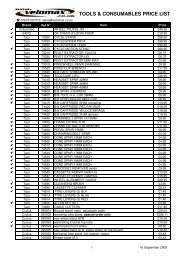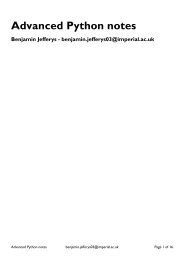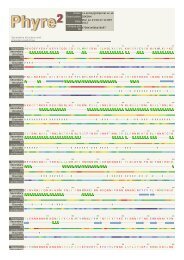the 3D-Dock Manual (PDF) - Structural Bioinformatics Group
the 3D-Dock Manual (PDF) - Structural Bioinformatics Group
the 3D-Dock Manual (PDF) - Structural Bioinformatics Group
You also want an ePaper? Increase the reach of your titles
YUMPU automatically turns print PDFs into web optimized ePapers that Google loves.
2 Algorithms<br />
This suite of programs is intended to be able to dock two proteins. This means starting<br />
from <strong>the</strong> known structures of two protein subunits of a biological complex known to exist, in<br />
unbound conformations, and ending up with a limited set of possible models for <strong>the</strong> complex.<br />
This overall algorithm is here achieved in up to 4 steps.<br />
1. a global scan of translational and rotational space of possible positions of <strong>the</strong> two<br />
molecules, limited by surface complementarity and an electrostatic filter (ftdock).<br />
2. an empirical scoring of <strong>the</strong> possible complexes using residue level pair potentials (rpscore<br />
(and rpdock)).<br />
3. using biological information to screen <strong>the</strong> possible complexes (filter).<br />
4. an energy minimisation and removal of steric clashes on <strong>the</strong> side-chains of <strong>the</strong> interface<br />
(multidock [3]).<br />
The middle two steps are interchangeable in <strong>the</strong> order in which <strong>the</strong>y are run, and <strong>the</strong> filter<br />
can be run more than once if so desired (see Tutorial). A schematic of <strong>the</strong> overall approach<br />
is shown in Figure 1.<br />
The ftdock algorithm is based on that of Katchalski-Katzir [4]. It discretises <strong>the</strong> two<br />
molecules onto orthogonal grids and performs a global scan of translational and rotational<br />
space. In order to scan rotational space it is necessary to rediscretise one of <strong>the</strong> molecules<br />
(for speed <strong>the</strong> smaller) for each rotation. The scoring method is primarily a surface complementarity<br />
score between <strong>the</strong> two grids, and this is shown in Figure 2. To speed up <strong>the</strong> surface<br />
complementarity calculations, which are convolutions of two grids, Fourier Transforms are<br />
used. This means that <strong>the</strong> convolutions are replaced with multiplications in Fourier space,<br />
and despite having to perform <strong>the</strong> forward and reverse Fourier Transforms, this decreases<br />
<strong>the</strong> overall computation required. The surface complementarity was <strong>the</strong> only score used in<br />
<strong>the</strong> original method. The original work on ftdock by Gabb [2] found it a useful addition to<br />
include an electrostatic filter, and this is again implemented in <strong>the</strong> current version (though<br />
it can be turned off).<br />
The rpscore program uses an empirical pair potential matrix to score each possible complex.<br />
The pair potentials are at a amino acid residue level. Each potential corresponds<br />
to <strong>the</strong> empirically derived likelihood of a trans-interface pair of two residue types, limited<br />
only by a distance cut off [5]. The present most useful matrix is generated from 90<br />
non-homologous interfaces found in <strong>the</strong> PDB with <strong>the</strong> aid of SCOP 1.53 (http://scop.mrclmb.cam.ac.uk/scop/),<br />
and is shown graphically in Figure 3. If two interfaces are described<br />
as pairings of domains A−B and C −D, <strong>the</strong>n a non-homologous interface is defined as being<br />
when ei<strong>the</strong>r A and C, or B and D, are homologous, but not both. Homology is in this case<br />
defined as being in <strong>the</strong> same ‘Superfamily’ in <strong>the</strong> SCOP classification tree.<br />
The biological filter is a simple program to screen <strong>the</strong> complexes by requiring <strong>the</strong>m to have a<br />
given chain or residue on one side of <strong>the</strong> interface within a certain distance of ano<strong>the</strong>r chain<br />
or residue on <strong>the</strong> o<strong>the</strong>r side. The manual (5.6) explains this in full.<br />
3





